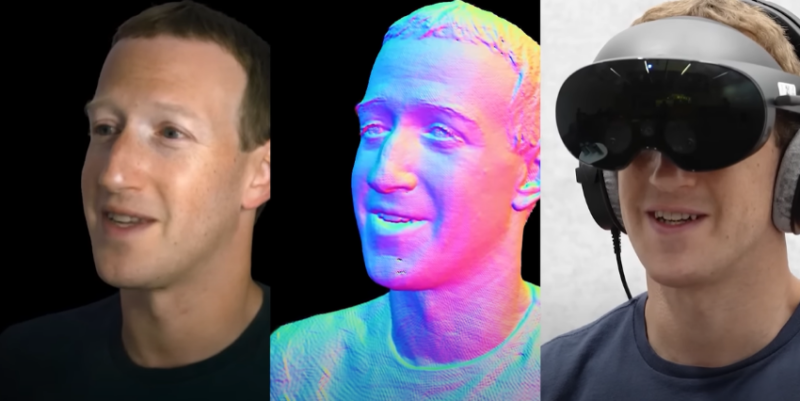Meta’s CEO, Mark Zuckerberg, recently sat down for an intriguing interview with podcast host Lex Fridman in the Metaverse. What unfolded in this conversation was nothing short of groundbreaking. Zuckerberg unveiled Meta’s latest innovation: photorealistic avatars for virtual reality (VR) communication. These avatars are transcending the boundaries of the “uncanny valley,” offering us a tantalizing glimpse into a future where VR meetings will make us feel like we’re physically sharing the same room with our counterparts.

You might also be interested: The 10 Best Metaverse Podcasts
Unlocking the Uncanny Valley
One of the most exciting aspects of Meta’s new photorealistic avatars is their ability to conquer the notorious “uncanny valley.” The uncanny valley refers to the eerie feeling we experience when a human-like avatar or robot looks almost real but still falls short in certain subtle ways. Meta’s avatars bridge this gap with remarkable finesse, delivering a level of realism that is truly astonishing.
The Avatar Creation Process

Creating these lifelike avatars is no small feat. Zuckerberg and Fridman participated in a thorough process to bring these avatars to life. They spent hours in a studio, their faces meticulously captured by various cameras as they contorted their expressions.
This data was the foundation for building motion-controllable avatar heads, breathing life into their digital alter egos. This process is time-consuming and requires Meta Quest Pro headsets, but rest assured, it will soon be accessible on the more budget-friendly Meta Quest 3.
Real-Time Facial Expression Tracking
The avatars are designed to track facial expressions, focusing on eye and mouth movements. The magic happens through the built-in cameras of VR headsets. These cameras continuously capture data on your expressions and audio from your microphone. The data is transmitted with near-zero latency to your conversation partner’s headset, making it possible for an incredibly realistic and intimate remote conversation.
The Future: Simplicity and Accessibility
Zuckerberg shared an exciting glimpse of the future in the interview, where the avatar creation process will become as simple as it is awe-inspiring. Soon, it will take a mere 2-3 minutes to create your own lifelike avatar, and you won’t need high-end equipment to do it. Imagine the convenience of waving your smartphone in front of your face, making a few expressions, and presto — a photorealistic avatar is born.
Revolutionizing VR Communication
The implications of Meta’s avatar technology for VR communication are nothing short of revolutionary. Here are some key aspects that make this innovation a game-changer:
- Enhanced Realism: With avatars that mirror your expressions and body language in real time, VR meetings will become incredibly lifelike. It’s as close to being physically present as you can get without leaving your home.
- Accessibility: Making this technology available on cheaper headsets means that more people will have access to immersive VR experiences. This accessibility will drive innovation and collaboration in ways we can only begin to imagine.
- Simplicity: The promise of a streamlined avatar creation process is a game-changer. No longer will you need specialized equipment and hours of studio time to create your digital doppelgänger. This simplicity will empower more individuals to dive into the Metaverse.
- Crossing Geographical Boundaries: VR communication transcends geographical boundaries. Whether you’re across the street or across the world, the Metaverse brings you together in a shared virtual space.
- Limitless Possibilities: As avatar technology evolves, it opens the door to endless possibilities. From virtual conferences to education, entertainment, and beyond, the Metaverse holds the promise of transforming how we interact and collaborate.
A Glimpse into the Metaverse
Mark Zuckerberg’s interview in the Metaverse serves as a window into the future of communication and connectivity. Meta’s dedication to creating lifelike avatars has the potential to revolutionize how we engage with each other, blurring the lines between the digital and physical worlds.
Imagine attending a business meeting where you can gauge your colleagues’ reactions, hold eye contact, and share a virtual whiteboard, all from the comfort of your home. Envision connecting with loved ones across the globe, feeling their presence as if they were right there beside you. This is the future that Meta’s avatars are bringing to our doorstep.
Closing Thoughts
Meta’s relentless pursuit of innovation is propelling us into a new era of VR communication. The introduction of photorealistic avatars that conquer the uncanny valley, combined with their vision for simplicity and accessibility, has the potential to reshape the way we connect, collaborate, and create.
As the Metaverse continues to evolve, it’s clear that we are on the cusp of a transformational shift in how we perceive and experience reality. The future of VR communication, as illuminated by Mark Zuckerberg’s interview, is a dazzling prospect that promises to redefine human interaction and transcend the boundaries of time and space. The question now is not if but when we will fully immerse ourselves in the limitless possibilities of the Metaverse.

